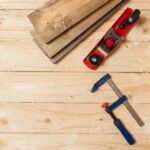Puppies chewing on woodwork can be a frustrating and potentially hazardous behavior for pet owners to address. Understanding the reasons behind this behavior is crucial in effectively preventing it. From teething to boredom or anxiety, there are various common reasons why puppies engage in woodwork chewing. By identifying these factors, pet owners can implement appropriate training techniques and provide suitable alternatives to redirect their puppy’s chewing habits.
Allowing puppies to chew on woodwork can pose significant dangers not only to your furniture but also to your furry companion’s health. Splinters and toxins from treated wood can harm your puppy’s mouth, digestive system, and overall well-being.
It is essential to take proactive steps to prevent this behavior and create a safe environment for your pet. Training techniques, such as positive reinforcement and providing appropriate chew toys, play a vital role in addressing and curbing woodwork chewing habits in puppies.
In this comprehensive guide, we will explore effective strategies to stop puppy chewing on woodwork. From puppy-proofing your home to seeking professional advice for persistent chewing behavior, we will equip you with the necessary tools to foster positive behaviors and discourage destructive habits in your beloved pet. Let’s delve into practical solutions for ensuring a safe and healthy environment for your puppy by addressing woodwork chewing habits head-on.
Common Reasons Behind Puppy Chewing Behavior
Puppies chewing on woodwork is a common behavior issue that many pet owners face. Understanding the reasons behind this behavior is crucial in effectively addressing and preventing it. One of the most common reasons why puppies chew on woodwork is teething.
Just like human babies, puppies go through a teething phase where they have the urge to chew to relieve the discomfort in their gums. In such cases, providing appropriate chew toys can help redirect their chewing behavior away from your woodwork.
Another reason why puppies may be inclined to chew on woodwork is out of boredom or anxiety. Puppies are full of energy and need mental stimulation to keep them engaged.
If they are not provided with enough physical exercise and mental enrichment, they may resort to inappropriate chewing as a way to release pent-up energy or alleviate stress. It’s important for pet owners to provide sufficient playtime, walks, and interactive toys to keep their puppies mentally stimulated and prevent them from turning to woodwork as a source of entertainment.
Additionally, some puppies may chew on woodwork due to curiosity or exploration. Puppies use their mouths to explore the world around them, much like human infants do with their hands. They might be attracted to the texture or taste of woodwork, especially if it has been treated with certain substances that make it appealing to them.
It’s essential for pet owners to supervise their puppies closely and intervene when they catch them in the act of chewing on woodwork. Redirecting their attention towards appropriate chew toys and rewarding positive behavior can help curb this habit before it becomes ingrained.
| Reasons Behind Puppy Chewing Behavior | Ways to Address |
|---|---|
| Teething phase | Provide appropriate chew toys |
| Boredom or anxiety | Ensure sufficient physical exercise and mental enrichment |
| Curiosity or exploration | Supervise closely, redirect attention towards appropriate chew toys |
By understanding these common reasons behind puppy chewing behavior, pet owners can take proactive steps to prevent their puppies from damaging woodwork in the home. Consistent training, supervision, and providing suitable alternatives for chewing can go a long way in curbing this undesirable habit and creating a safe environment for both the puppy and the household. Remember, patience and consistency are key when addressing any behavioral issues in young dogs like excessive chewing on woodwork.
Potential Dangers of Allowing Puppies to Chew on Woodwork
Puppies have a natural instinct to chew as they go through the teething phase, but allowing them to chew on woodwork can pose several dangers. It is important for pet owners to understand the potential risks associated with this behavior in order to prevent any harm to their furry companions. Here are some of the dangers of allowing puppies to chew on woodwork:
- Damage to teeth and gums: The hard surfaces of woodwork can cause damage to a puppy’s developing teeth and delicate gums. Splinters from the wood can also injure their mouths, leading to pain and discomfort.
- Choking hazards: When puppies chew on woodwork, there is a risk of them swallowing small pieces of wood that could potentially become choking hazards. These foreign objects may get lodged in their throat, blocking airflow and posing a serious threat to their health.
- Toxicity concerns: Certain types of wood treated with chemicals or paints can be toxic when ingested by puppies. Consuming these toxic substances can lead to poisoning symptoms such as vomiting, diarrhea, and even organ damage.
To prevent these potential dangers, it is crucial for pet owners to take proactive measures in training their puppies and providing safe alternatives for chewing. By addressing the underlying reasons behind puppy chewing behavior and creating a puppy-proof environment, pet parents can ensure a safe and healthy living space for their furry friends while avoiding woodwork damage.
Remember, understanding the risks associated with allowing puppies to chew on woodwork is the first step towards addressing this behavior effectively. Through proper training techniques, offering suitable chew toys, and implementing puppy-proofing strategies, you can help your puppy develop positive chewing habits and maintain a safe environment in your home while minimizing the risk of accidents and health issues.
Training Techniques to Prevent Puppy Chewing on Woodwork
Puppies chewing on woodwork can be a frustrating behavior for pet owners to deal with. However, understanding why puppies engage in this behavior is crucial in order to effectively address and prevent it. One common reason behind puppy chewing on woodwork is the teething process.
Just like human babies, puppies go through a teething phase where they feel the need to chew on objects to relieve discomfort from their growing teeth. In addition, puppies may also chew out of boredom, curiosity, or as a way to alleviate stress or anxiety.
To stop puppy chewing woodwork, it is important to implement proper training techniques. Here are some effective methods to prevent puppies from damaging your woodwork:
1. Provide appropriate chew toys: Make sure to offer your puppy a variety of safe and durable chew toys that are specifically designed for teething. This will redirect their chewing behavior towards appropriate items.
2. Supervise and redirect: Keep a close eye on your puppy when they are roaming around the house and immediately redirect their attention to a chew toy if you catch them attempting to chew on woodwork.
3. Use deterrent sprays: Consider using bitter-tasting sprays or deterrents that can be applied to wood surfaces to discourage puppies from chewing on them.
By consistently implementing these training techniques, you can effectively teach your puppy what is acceptable to chew on and help prevent damage to your woodwork.
Remember that patience and consistency are key when addressing unwanted chewing behaviors in puppies. With the right training and guidance, you can successfully stop puppy chewing woodwork and create a safe environment for your furry friend.
Recommended Chew Toys and Alternatives to Redirect Puppy’s Chewing Behavior
Puppies have a natural tendency to explore the world around them with their mouths, which often leads to them chewing on woodwork. It is crucial for pet owners to understand why puppies exhibit this behavior in order to effectively address it. One common reason behind puppy chewing on woodwork is teething. Just like human babies, puppies go through a teething phase where they experience discomfort in their gums, leading them to seek relief by chewing on objects.
Another reason for puppy chewing on woodwork could be boredom or lack of mental stimulation. Puppies are curious and active animals that need constant engagement to prevent destructive behavior such as chewing. Providing appropriate chew toys and alternatives can help redirect their focus and energy away from woodwork.
Allowing puppies to chew on woodwork can pose potential dangers not only to your furniture but also to the health of your pet. Splinters from chewed wood can cause injuries in your puppy’s mouth or digestive tract if ingested.
In addition, some types of wood treated with chemicals can be toxic when consumed. Therefore, it is important for pet owners to take proactive measures to stop puppy chewing on woodwork and provide safe alternatives for their teething or bored pets.
| Reasons for Puppy Chewing Behavior | Potential Dangers |
|---|---|
| Teething | Injuries from splinters |
| Boredom or Lack of Mental Stimulation | Toxicity from chemically treated wood |
How to Properly Puppy-Proof Your Home to Avoid Woodwork Damage
Puppies are notorious for their curious and exploratory nature, which often leads them to chew on anything they can get their teeth on, including your precious woodwork. To prevent damage to your home and keep your furry friend safe, it is essential to puppy-proof your living space effectively. Here are some key steps to take in order to avoid woodwork damage caused by your teething pup.
First and foremost, it is crucial to remove any temptation from your puppy’s reach. This means clearing out any loose or dangling cords, cables, or objects that may attract your puppy’s attention. Keep your floors clutter-free and make sure all valuable wooden items are safely stored away. By eliminating potential chewing targets, you can significantly reduce the risk of your puppy damaging the woodwork in your home.
Additionally, creating designated chewing zones for your puppy can help redirect their natural urge to chew onto more appropriate surfaces. Invest in sturdy chew toys specifically designed for teething puppies and rotate them regularly to keep things interesting.
Providing a variety of textures and materials will keep your puppy engaged and satisfied while sparing your woodwork from destruction. Remember to praise and reward your pup whenever they choose to chew on their toys instead of the furniture, reinforcing the desired behavior effectively.
Professional Advice on Addressing Persistent Chewing Habits in Puppies
Consulting a Veterinarian or Animal Behaviorist
If your puppy’s chewing on woodwork persists despite your best efforts to redirect their behavior, it may be time to seek professional advice. A veterinarian or animal behaviorist can help assess any underlying reasons for the behavior and provide tailored solutions to address it. They may suggest specific training techniques, behavioral modifications, or even medical interventions if necessary.
Implementing a Consistent Training Plan
Consistency is key when trying to curb persistent chewing habits in puppies. Set clear boundaries and rules for your pup regarding what is acceptable to chew on and what is off-limits. Use positive reinforcement techniques such as praise, treats, or toys to reward good behavior and discourage destructive chewing. Remember that patience and repetition are crucial in helping your puppy unlearn this habit.
Exploring Environmental Enrichment Options
Sometimes, puppies chew on woodwork out of boredom or excess energy. Providing plenty of physical exercise, mental stimulation, and interactive playtime can help alleviate their need to gnaw on furniture or walls. Consider puzzle toys, food-dispensing toys, or rotating different types of chew toys to keep your puppy engaged and entertained. By addressing the root cause of their chewing behavior, you can effectively stop puppy chewing woodwork in the long run.
Tips for Reinforcing Positive Behavior and Discouraging Woodwork Chewing in Puppies
Puppies, like human babies, explore the world around them through their mouths. This natural behavior can sometimes lead to destructive chewing of woodwork in your home.
While it may be frustrating to come home to chewed-up baseboards or furniture legs, it’s essential to understand that this behavior is often a result of teething, boredom, or anxiety. By implementing proper training techniques and providing appropriate chew toys, you can help redirect your puppy’s chewing behavior and protect your woodwork from damage.
Positive Reinforcement Training
One effective way to discourage woodwork chewing in puppies is through positive reinforcement training. When you catch your puppy in the act of chewing on woodwork, firmly say “no” and redirect their attention to an appropriate chew toy.
Once they start chewing on the toy instead, praise them with treats or verbal cues like “good boy/girl.” Consistency is key when using positive reinforcement, so make sure to reward your puppy every time they choose the right object to chew on.
Discouraging Negative Behavior
In addition to positive reinforcement, it’s important to deter your puppy from chewing on woodwork by making the behavior less appealing. You can do this by applying bitter-tasting sprays or deterrents specifically designed for pets on the areas they tend to chew.
Another method is using baby gates or barriers to block off access to rooms with woodwork until your puppy learns what they are allowed and not allowed to chew on. By creating boundaries and making woodwork less attractive as a target for chewing, you can help break this habit in your furry friend.
Increasing Mental Stimulation
Often times, puppies resort to destructive chewing out of boredom or lack of mental stimulation. To prevent this behavior, make sure your puppy gets enough exercise and playtime throughout the day. Interactive toys like puzzle feeders or treat dispensers can keep your puppy engaged and mentally stimulated.
Engaging in training sessions or teaching new tricks can also help tire out your puppy both mentally and physically, reducing the likelihood of them turning to woodwork as a source of entertainment. Remember that a tired pup is a happy pup – one who is less likely to engage in destructive behaviors like chewing on woodwork.
Conclusion
In conclusion, it is crucial for dog owners to address the issue of puppy chewing on woodwork to ensure a safe and healthy environment for their furry companions. By understanding the reasons behind this behavior and taking proactive steps to prevent it, such as providing appropriate chew toys and properly puppy-proofing your home, you can effectively stop puppy chewing woodwork.
Not only does this help protect your furniture and fixtures from damage, but it also prevents potential health hazards for your puppy.
Training techniques like positive reinforcement and redirection can be highly effective in teaching puppies what is acceptable to chew on and what is not. Consistency in implementing these techniques is key to breaking the habit of woodwork chewing in puppies. Seeking professional advice if your puppy’s chewing habits persist despite your efforts can also provide valuable insights on how to address this behavior effectively.
Ultimately, by reinforcing positive behavior and discouraging woodwork chewing through training and providing alternatives, you can create a safe environment where both you and your puppy can coexist harmoniously. Remember that patience, consistency, and understanding are essential in guiding your puppy towards developing healthy chewing habits while fostering a strong bond between the two of you. So take action now to stop puppy chewing woodwork and create a secure space where your pet can thrive.
Frequently Asked Questions
How Do I Get My Puppy to Stop Chewing on Wood Trim?
To get your puppy to stop chewing on wood trim, it is important to provide them with appropriate chew toys and redirect their attention whenever you catch them in the act. Consistency is key to teaching them what is acceptable to chew.
What Can I Put on Wood to Stop Puppy Chewing?
There are several options to consider when looking for something to put on wood to stop puppy chewing. Bitter apple spray, citrus-based sprays, or even a homemade mixture of vinegar and water can help deter puppies from wanting to chew on wood surfaces.
What Can I Put on My Baseboards to Keep Dogs From Chewing?
If you want to keep dogs from chewing on your baseboards, one effective solution is utilizing bitter-tasting sprays or deterrents specifically designed for pet-proofing furniture. Additionally, providing an ample supply of chew toys and regularly exercising your dog can help prevent unwanted chewing behavior.

Hi everyone! I’m a woodworker and blogger, and this is my woodworking blog. In my blog, I share tips and tricks for woodworkers of all skill levels, as well as project ideas that you can try yourself.





